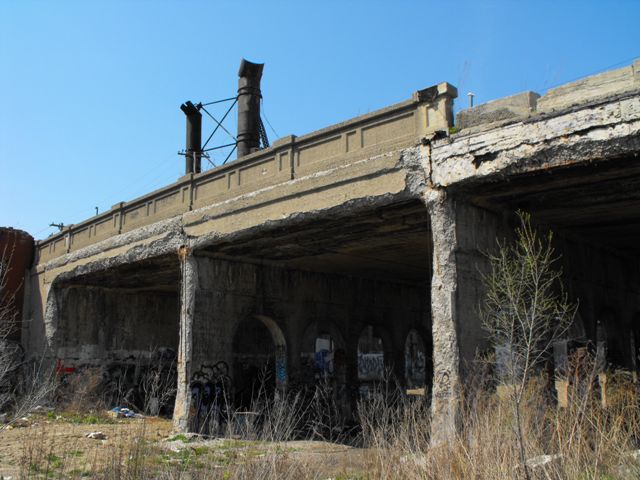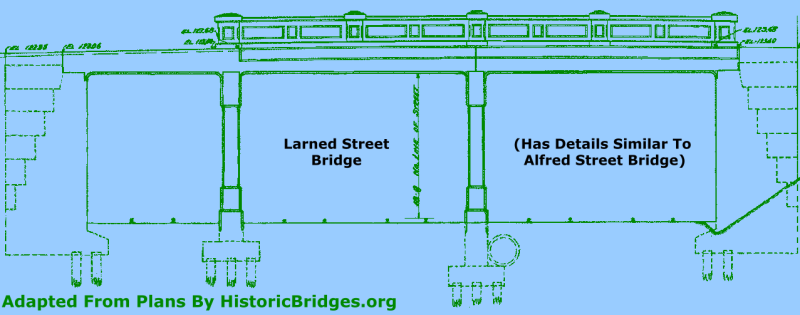We Recommend:
Bach Steel - Experts at historic truss bridge restoration.
BridgeHunter.com Phase 1 is released to the public! - Visit Now
Alfred Street Bridge

Primary Photographer(s): Nathan Holth and Rick McOmber
Bridge Documented: July 1, 2007 and April 10, 2010
Alfred Street Over Railroad (Abandoned Grand Trunk Western / Dequindre Cut Greenway)
Detroit: Wayne County, Michigan: United States
Not Available or Not Applicable
33.8 Feet (10.3 Meters)
97.8 Feet (29.8 Meters)
30 Feet (9.14 Meters)
3 Main Span(s)
825180800076R01

View Information About HSR Ratings
Bridge Documentation
This bridge no longer exists!
View Original Plans For This Bridge
About The Dequindre Cut Bridges
This bridge is one of several remaining historic bridges that cross an old abandoned Grand Trunk Western line called the Dequindre Cut, which was built as a depressed rail line so that not only could grade separation bridges could be built to maintain the flow of vehicular traffic, these grade separations could be built without an approach, reducing land acquisition. This was the same concept executed with many of the interstate highways in Detroit, which are depressed freeways. The Dequindre Cut was created to deal with the rapid growth that Detroit experienced in the early 20th Century. The rail line runs from roughly Mack Avenue to Jefferson Avenue along St. Aubin Street.
The Antietam Avenue Bridge and the Chestnut Street Bridge were highlighted as specific bridges which were individually eligible for the National Register of Historic Places. Visit those pages for historical narratives from the Historic Bridge Inventory. Although only these two bridges were highlighted as individually eligible, it was noted that the entire Dequindre Cut formed a potential historic district, and if such a historic district were created, all these surviving bridges would become eligible for the National Register as contributing structures to the historic district. Further, the demolition of the Antietam Avenue Bridge means that perhaps one of the other surviving examples found not individually eligible should be re-evaluated for eligibility in light of the increased rarity of surviving examples of these bridges.
There were once many more bridges along the Dequindre Cut than were present when HistoricBridges.org documented the bridges in 2007 and 2010. In 1930, there were a total of 16 bridges. A number of these bridges have been demolished with no replacement built. Today, the abutments of many of these demolished bridges remain as evidence of heritage lost. In addition, some of the original bridges have been replaced with new bridges. Worse, those bridges which remain are in very poor condition with extensive spalling, cracking, and efflorescence observed and as such these bridges are likely at risk for demolition. The only redeeming consideration for these bridges is that this area of Detroit experiences far less traffic, particularly truck traffic, than it would have decades ago. The extensive industry that was once around this railroad line is largely demolished or abandoned, with only a few properties appearing to be active.
The design of the bridges are all very similar, with most bridges having two or three spans. The bridges include concrete railings with inset rectangles cast into the railing panels and the railing posts. The bridges have arched concrete piers. The superstructure of the bridge has the appearance of a concrete slab, although an unusual detail observed on some of the bridges was under the sidewalks, where the bridge had an appearance of a t-beam with individual beams rather than a solid slab. Despite these appearances, the bridges are listed as steel stringers in the National Bridge Inventory. This could imply that the bridges are concrete encased steel stringer bridges, which are rare for highway bridges in Michigan, or it could imply that the bridges are listed incorrectly in the National Bridge Inventory.
There are some differences from the above description in a few bridges. The Wilkins Street Bridge has only one sidewalk and the railings for the side without a sidewalk have a different design. The Thornhill Place Bridge has a single span instead of two or three and unlike the other bridges its sidewalks are cantilevered. The Antietam Avenue Bridge has steel bents instead of the usual concrete piers.
Recently, the Dequindre Cut has been finding new life as the Dequindre Cut Greenway, which is currently a non-motorized trail that runs in the section south of Gratiot Avenue. Future plans include extending the trail north of Gratiot to Mack Avenue, and also adding a light rail transit system which would also run in it. Unfortunately, the preservation of the historic bridges does not appear to have been included as part of this project. The preservation of the historic bridges should be considered an essential part of the project since they contribute to the aesthetic and historical qualities of the Dequindre Cut Greenway.
About the Alfred Street Bridge
Alfred Street Bridge has three spans making it among the longer examples of these bridges. It is also in much poorer structural condition that many of the other bridges. Although the bridge would appear at first glance to be missing railings on one of the spans, HistoricBridges.org found the plans for the Larned Street Bridge in the replacement bridge bid package. This now-demolished structure in its original form was apparently quite similar to the Alfred Street Bridge. For some unknown reason, the original plans for the bridge show no railings on one of the spans. Because of this, it seems likely the Alfred Street Bridge was also designed in this manner, with the modern New Jersey Barriers added at a later date for obvious safety reasons. It is unclear why these bridges were designed with one span lacking railings. It is highly unusual, and even with less concern for vehicular protection, the importance of providing fall protection for pedestrians should still have been a concern at the time this bridge was built.
![]()
Photo Galleries and Videos: Alfred Street Bridge
Bridge Photo-Documentation
Original / Full Size PhotosA collection of overview and detail photos. This gallery offers photos in the highest available resolution and file size in a touch-friendly popup viewer.
Alternatively, Browse Without Using Viewer
![]()
Bridge Photo-Documentation
Mobile Optimized PhotosA collection of overview and detail photos. This gallery features data-friendly, fast-loading photos in a touch-friendly popup viewer.
Alternatively, Browse Without Using Viewer
![]()
Maps and Links: Alfred Street Bridge
This historic bridge has been demolished. This map is shown for reference purposes only.
Coordinates (Latitude, Longitude):
Search For Additional Bridge Listings:
Bridgehunter.com: View listed bridges within 0.5 miles (0.8 kilometers) of this bridge.
Bridgehunter.com: View listed bridges within 10 miles (16 kilometers) of this bridge.
Additional Maps:
Google Streetview (If Available)
GeoHack (Additional Links and Coordinates)
Apple Maps (Via DuckDuckGo Search)
Apple Maps (Apple devices only)
Android: Open Location In Your Map or GPS App
Flickr Gallery (Find Nearby Photos)
Wikimedia Commons (Find Nearby Photos)
Directions Via Sygic For Android
Directions Via Sygic For iOS and Android Dolphin Browser
USGS National Map (United States Only)
Historical USGS Topo Maps (United States Only)
Historic Aerials (United States Only)
CalTopo Maps (United States Only)



